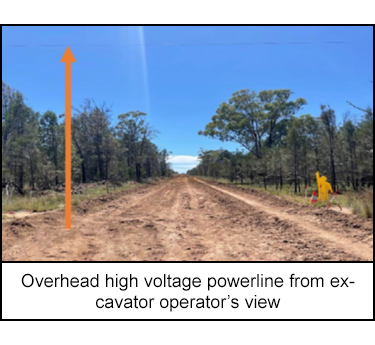-
What happened?
The boom arm of a 25-tonne (55,116 lbs) excavator contacted a 12,700 V overhead powerline causing the powerline to fall to the ground adjacent to the excavator.
The excavator was in the process of clearing an access track.
The incident occurred at 3pm.
Wet weather the night before had brought this work scope forward.
No injuries were sustained from this event.

-
Why did it happen?
The excavator operator had prepared a dirt bund to act as a warning barrier. However it was later removed by the grader operator, who was unaware that the bund was in place to stop the excavator operator from getting too close to the overhead powerline.
At the time of the incident the excavator operator was travelling back along the access track behind the grader.
The excavator boom arm was raised and the bucket extended to not disturb the 600mm (24 inches) windrow the grader operator was making.
As the excavator continued along the access track the operator lost sight of the powerline due to the clear blue sky, and the raised excavator boom blocked the operator’s view of the single yellow “safety man” being used to identify the location of the powerline.

-
What did they learn?
When plans change due to unforeseen events (e.g. wet weather), verify that alternative worksites are ready for work to start. Confirm that all risks have been assessed at the alternative worksite and the appropriate controls put in place prior to starting work.
Confirm that a written procedure is in place for working around overhead powerlines and required exclusion zones. Confirm that field personnel know about the procedure and verify that they understand it.
Ensure human performance elements are addressed in critical procedures, to support improved procedural discipline.
When agreed controls are in place, verify they are fit-for-purpose, clearly identifiable, and continuous improvement opportunities discussed.
When setting up alert markers/barriers, consider blind spots and limited visibility from within mobile plant cabs.
Visually check and confirm powerline heights, install suitable flagging and warning signage, consider alternate mobile plant and, when required, have competent spotter(s) in place.

-
Ask yourself or your crew
Do you operate mobile plant near live powerlines?
How do you identify the hazards prior to operating mobile plant near live overhead powerlines?
What controls do you have in place?
When errors occur at your workplace, do you and your colleagues pause to discuss how and why they occurred, and what can be done to prevent them reoccurring?

Add to homescreen
Content name
Select existing category:
Content name
New collection
Edit collection
What happened?
The boom arm of a 25-tonne (55,116 lbs) excavator contacted a 12,700 V overhead powerline causing the powerline to fall to the ground adjacent to the excavator.
The excavator was in the process of clearing an access track.
The incident occurred at 3pm.
Wet weather the night before had brought this work scope forward.
No injuries were sustained from this event.

Why did it happen?
The excavator operator had prepared a dirt bund to act as a warning barrier. However it was later removed by the grader operator, who was unaware that the bund was in place to stop the excavator operator from getting too close to the overhead powerline.
At the time of the incident the excavator operator was travelling back along the access track behind the grader.
The excavator boom arm was raised and the bucket extended to not disturb the 600mm (24 inches) windrow the grader operator was making.
As the excavator continued along the access track the operator lost sight of the powerline due to the clear blue sky, and the raised excavator boom blocked the operator’s view of the single yellow “safety man” being used to identify the location of the powerline.
What did they learn?
When plans change due to unforeseen events (e.g. wet weather), verify that alternative worksites are ready for work to start. Confirm that all risks have been assessed at the alternative worksite and the appropriate controls put in place prior to starting work.
Confirm that a written procedure is in place for working around overhead powerlines and required exclusion zones. Confirm that field personnel know about the procedure and verify that they understand it.
Ensure human performance elements are addressed in critical procedures, to support improved procedural discipline.
When agreed controls are in place, verify they are fit-for-purpose, clearly identifiable, and continuous improvement opportunities discussed.
When setting up alert markers/barriers, consider blind spots and limited visibility from within mobile plant cabs.
Visually check and confirm powerline heights, install suitable flagging and warning signage, consider alternate mobile plant and, when required, have competent spotter(s) in place.
Ask yourself or your crew
Do you operate mobile plant near live powerlines?
How do you identify the hazards prior to operating mobile plant near live overhead powerlines?
What controls do you have in place?
When errors occur at your workplace, do you and your colleagues pause to discuss how and why they occurred, and what can be done to prevent them reoccurring?
While clearing an access track, a 25-tonne (55,116 lbs) excavator’s boom arm hit a 12,700 V overhead powerline, causing it to fall to the ground. Fortunately, no injuries were reported despite the incident being prompted by wet weather the previous night.
Original material courtesy of Safer Together (Australia)
To access the PDF and PowerPoint versions, please visit https://www.safertogether.com.au/resources/sharing-library/operating-mobile-plant-contact-with-live-electricity-leb-toolbox













